
Very Large Array
Socorro and the Very Large Array
I drove south from the Petroglyph National Monument
to Socorro,
a nice base for seeing things in the area.
My main destination around Socorro was the
Very Large Array —
twenty-seven radio telescope antennas,
each of them a dish 25 meters wide,
moved to varying positions
on a Y of three 21-kilometer tracks.
The VLA observes the universe at frequencies
from 73 MHz to 50 GHz.
The associated Long Wavelength Array operates
at 10–88 MHz.
Back in Socorro, I explored the town.
And, as a warm-up for Roswell,
I found that Socorro has its own
UFO encounter legend.
But first, I had to drive south.
Here's the view from a rest stop along I-25,
a short distance north of Socorro.
Some late afternoon "dry rain" is falling from the clouds
but evaporating as it reaches the ground.
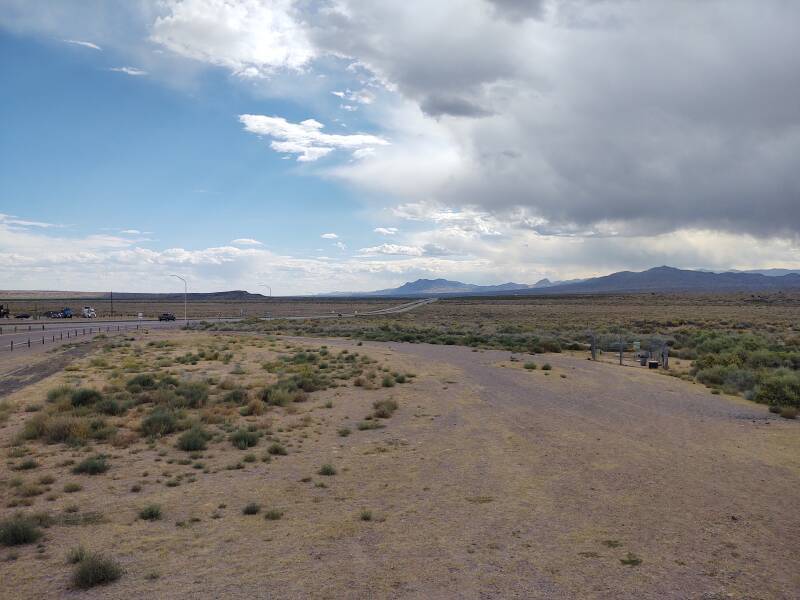
Socorro
Accommodations at Booking.comI stayed at the Economy Inn along California Street, the main north-south street in Socorro paralleling I-25. There's the gigantic truck that Budget stuck me with.
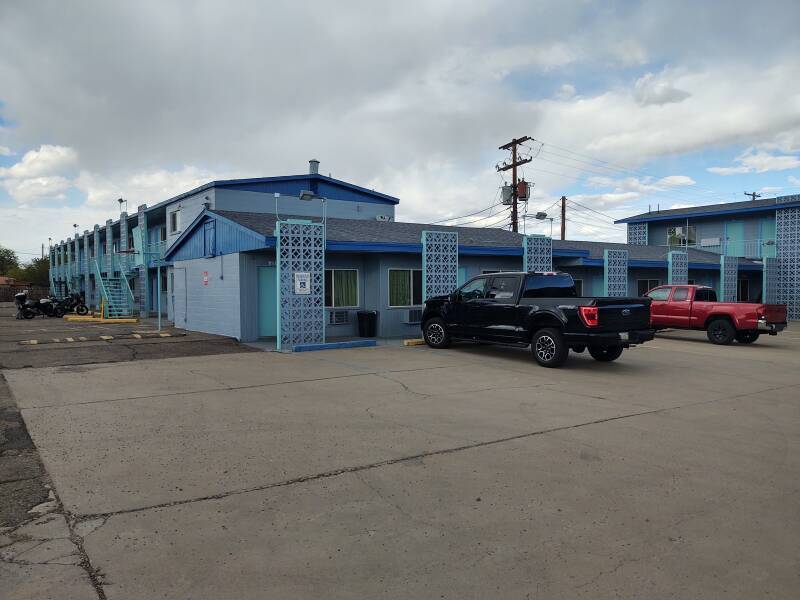
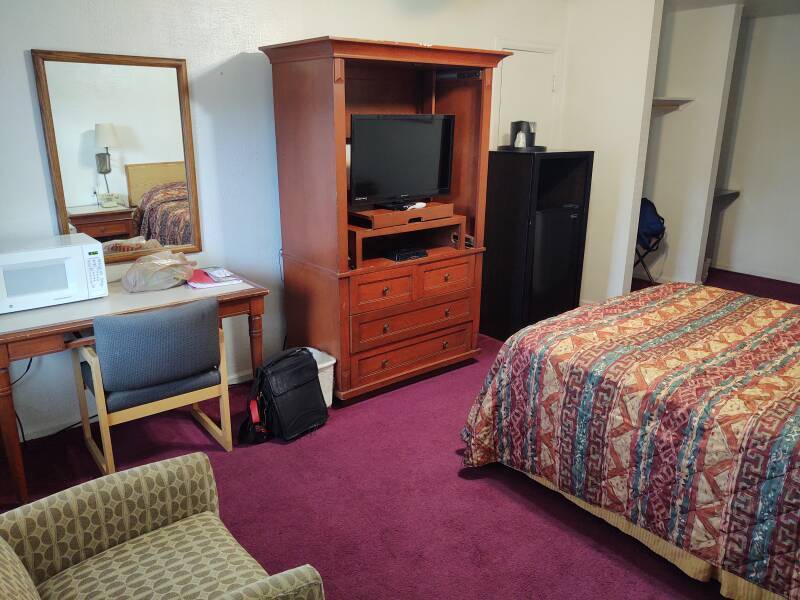
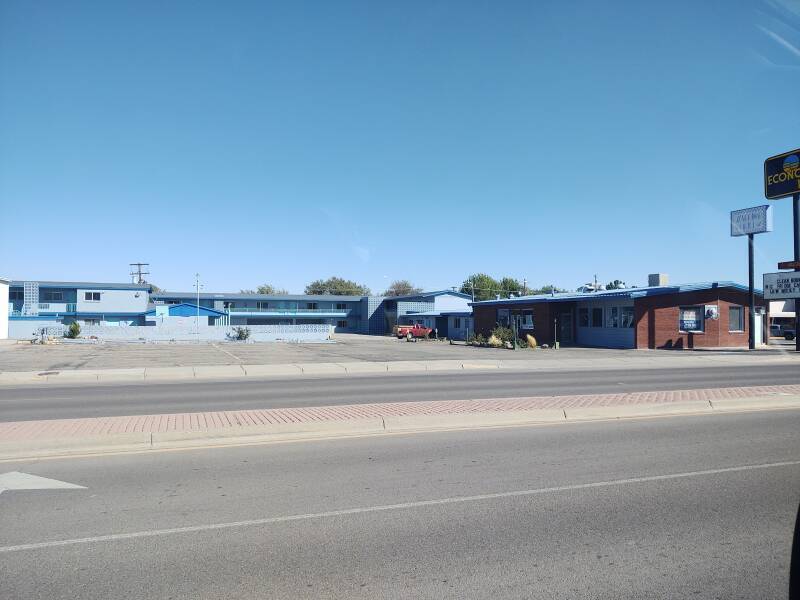
The Lonnie Zamora Incident
I was on my way to Roswell, where the centerline of an annular solar eclipse would pass very close to the center of town in a few days. Of course Roswell is now largely known for the July 1947 Roswell Incident that happened during a flying disc craze. The U.S. Air Force published a report in 1994 saying that the Roswell object was part of Project Mogul, at the time a Top Secret project using balloons for long-distance detection of sound waves generated by Soviet nuclear bomb tests. Conspiracy theories continue to insist that it was an extraterrestrial craft.
Well, Socorro has its own Lonnie Zamora Incident.
On April 24, 1964, Socorro police office Lonnie Zamora reported that he saw two people beside a shiny O-shaped object, which later rose into the air propelled by a roaring blue and orange flame.
Zamora said that it had all started while he was chasing a speeding car when he "heard a roar and saw a flame in the sky to the southwest some distance away — possibly a half-mile or a mile."
He thought that a nearby dynamite shack might have blown up, so he abandoned the automotive chase and went to investigate the possible explosion. He reported seeing a shiny object "to the south about 150 to 200 yards" and initially thought it was an overturned white car.
After getting a better view of it, he said that the object was shaped "like the letter O" with a surface "like aluminum — it was whitish against the mesa background, but not chrome."
Zamora said that he briefly saw two people wearing white coveralls and standing beside the object. They might have been the size and general appearance of adult humans, "but possibly they were small adults or large kids." Or, of course, Little Green Men. He said that he then heard a roar and saw a blue and orange flame under the object as it quickly rose into the air and flew away.
One possible explanation is that he saw a lunar lander flight test at White Sands Missile Range, about 60 kilometers to the southeast, even though he said that he initially saw the flame in the air to his southwest. Early development and testing of the Lunar Module was going on in 1964, and would involve a loud rocket emitting flames.
Another possibility is that New Mexico Tech students launched a small hot-air balloon made from a dry-cleaning bag made of thin clear plastic, with an X-shaped spreader at the base made from paper or plastic straws, holding a birthday cake candle as the balloon's fuel for lift. There's no "roaring flame" with that design, or with the often-cited confusion with Venus or a bright star, but nearby truck engines could be mistakenly associated with the sight.
As I was walking from my motel to the town square, in the second block I passed this shop. See Lonnie's silhouette left of center, between the first and second green extraterrestrials.
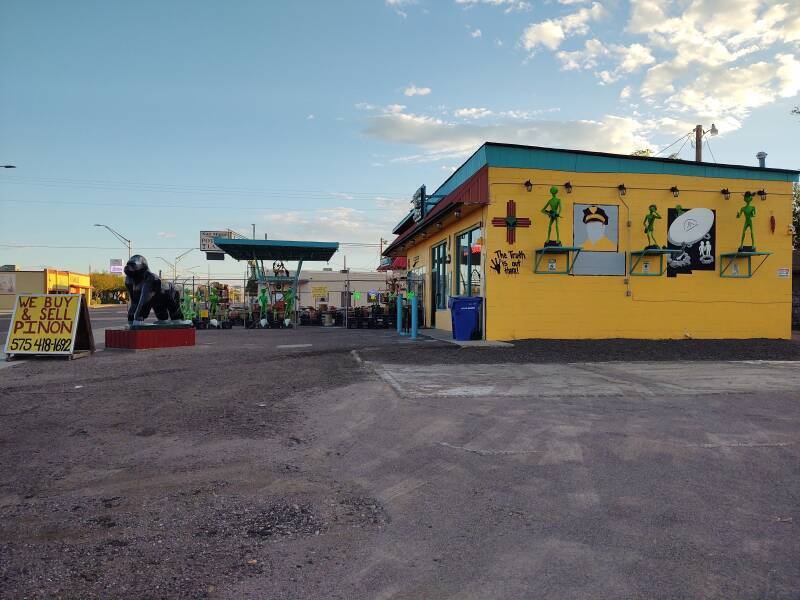
San Miguel Pottery Land was the best place in town to pick up pottery and extraterrestrial statues.

At the end of this page you'll see pictures of the Lonnie Zamora Incident site. This first evening in town, I continued on to the central square. Some people were still hanging out after that day's farmers' market.
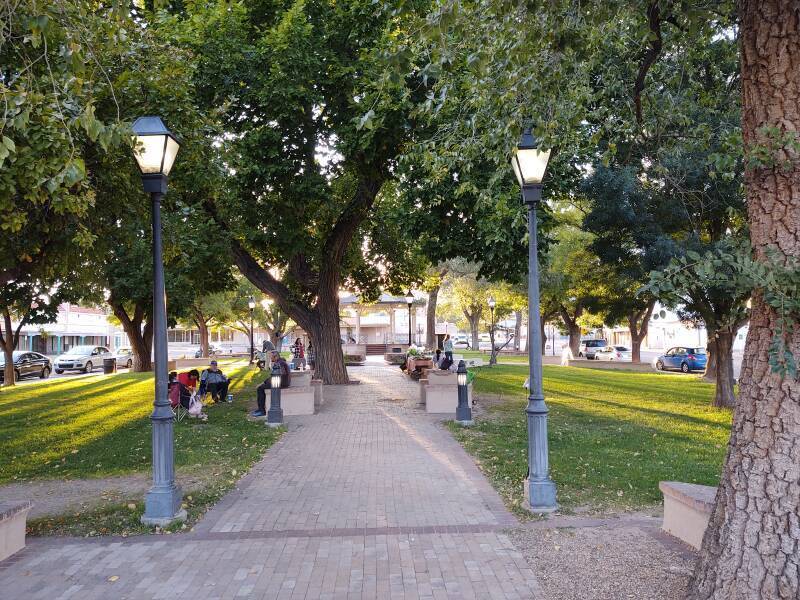
Capitol Bar is on the southeast corner of the square.
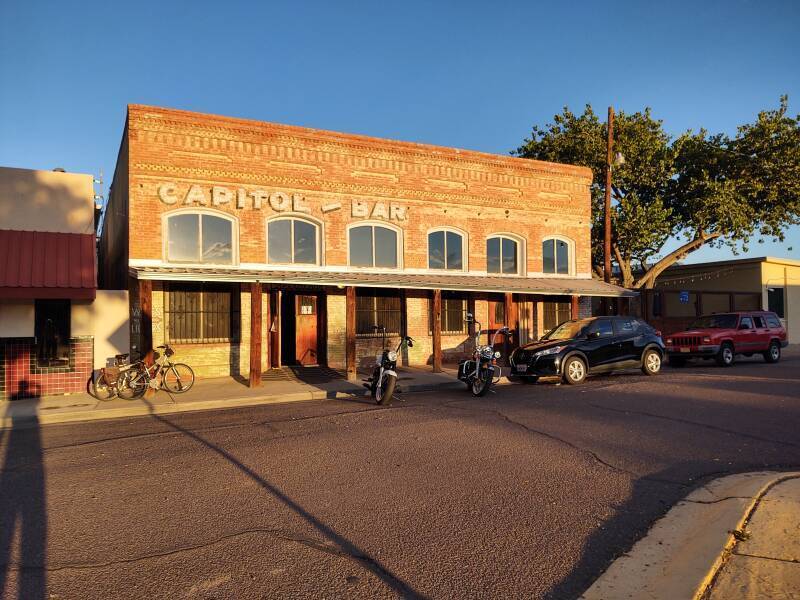
The Capitol Bar started as a saloon built in 1896. The owner, Giovanni Biavaschi, sold the wine that he made. Socorro was the largest town in the New Mexico Territory at the time, with over 3,000 residents working in mining, retail, and operating the town's 30 saloons. The Capitol is the only one of those that still exists.
A local judge operated the bar in the early 1900s, holding court in the bar at the front, and locking up prisoners in jail cells in the back.
In 2021, the jail section was turned into a microbrewery. I had one of the local beers. This one contained green chile pepper. But that's a lime slice on the rim of the glass.
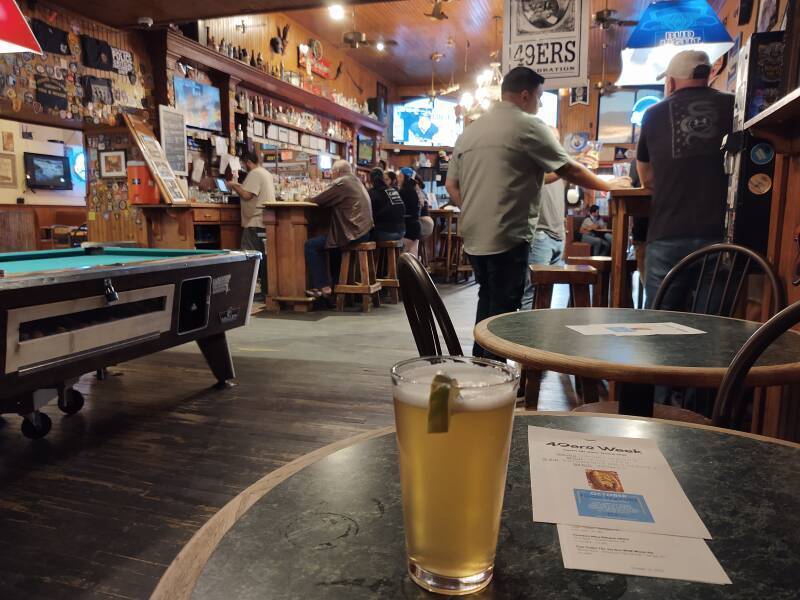
West from Socorro
I drove west on U.S. 60 from Socorro. Highway signs in town, and also out on I-25, indicated that this was the way to the Very Large Array. New Mexico is near the bottom of the list of U.S. states in terms of the quality of primary and secondary school education. Its sparse population and many small, isolated communities makes education more of a challenge. But, because of Los Alamos National Laboratory and Sandia National Laboratories, and their contractors, it has had the highest percentage of residents with a Ph.D. Science is a big deal in New Mexico, but the kids don't necessarily get much of it in school.
The highway climbed to the west out of Socorro. Then, nearing Magdalena, it went around the north end of a ridge. The Magdalena Ridge Observatory, run by New Mexico Tech and the Cavendish Astrophysics Group of the University of Cambridge, is up there in that restricted airspace box. The main funder is the U.S. Naval Research Lab. They observe satellites for the U.S. Navy and U.S. Air Force, and also track near-Earth asteroids and comets for NASA.
Between the town of Magdalena and the small settlement of Datil, the highway crosses a broad flat area that was a lake during the Pleistocene period, reaching its maximum size before the Last Glacial Maxumum about 20,900 years ago.
It's a large flat area, at an elevation of about 7,000 feet or 2,125 meters, surrounded by higher mountains, with very few people living in the area. All of that made it well-suited for a large radio telescope. See the Y shaped tracks left of center.
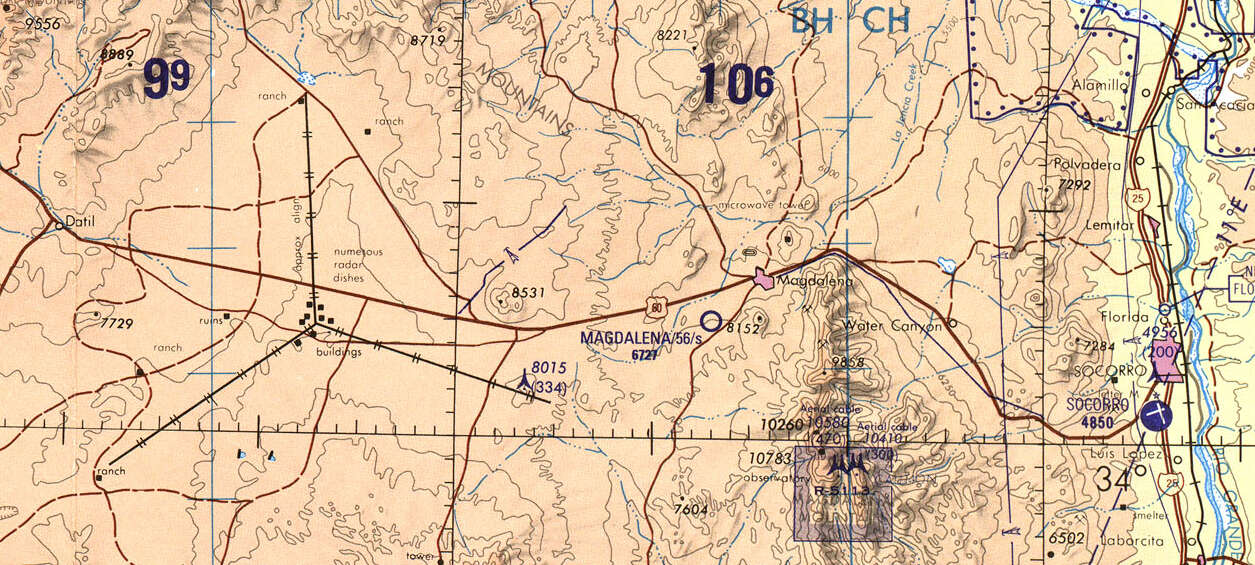
1:500,000 scale Tactical Pilotage Chart TPC G-19C from the Perry Castañeda Library Map Collection at the University of Texas.
The high ground west of Socorro has a very No Country for Old Men look.
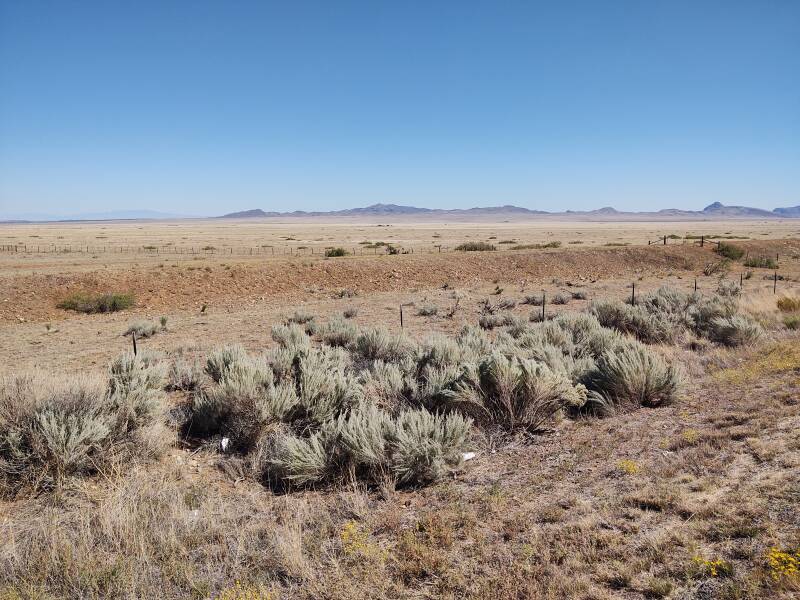


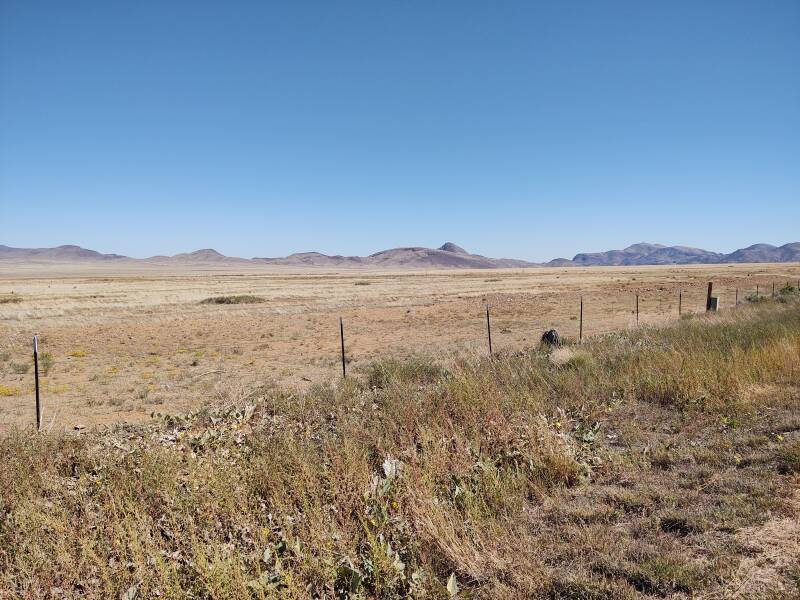
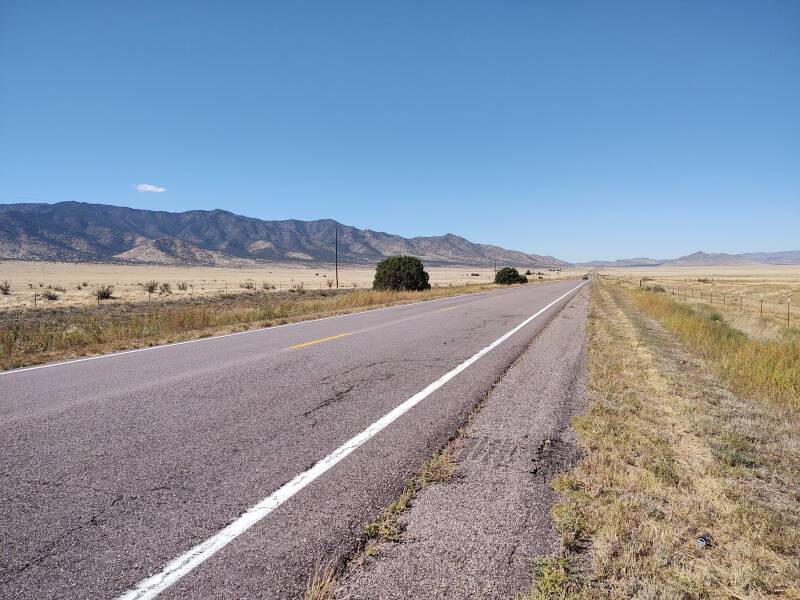

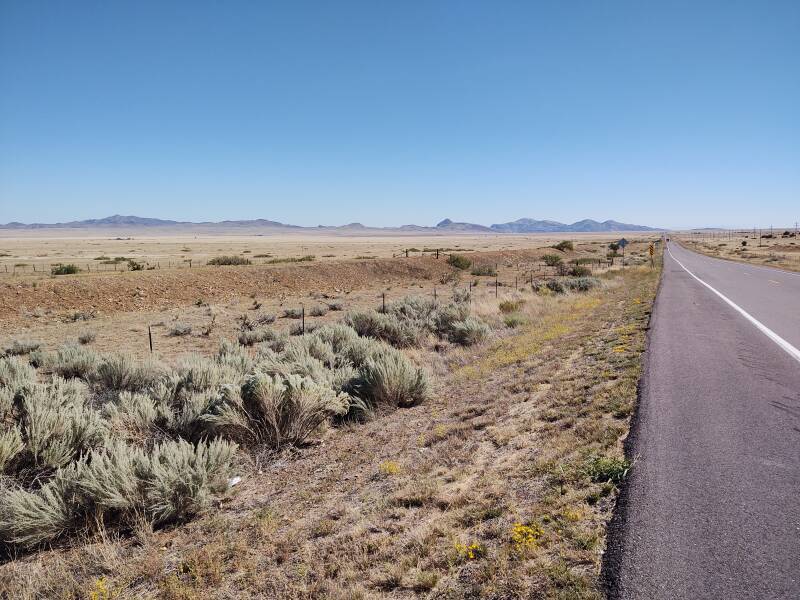
Past Magdalena you start to see the dishes in the distance.
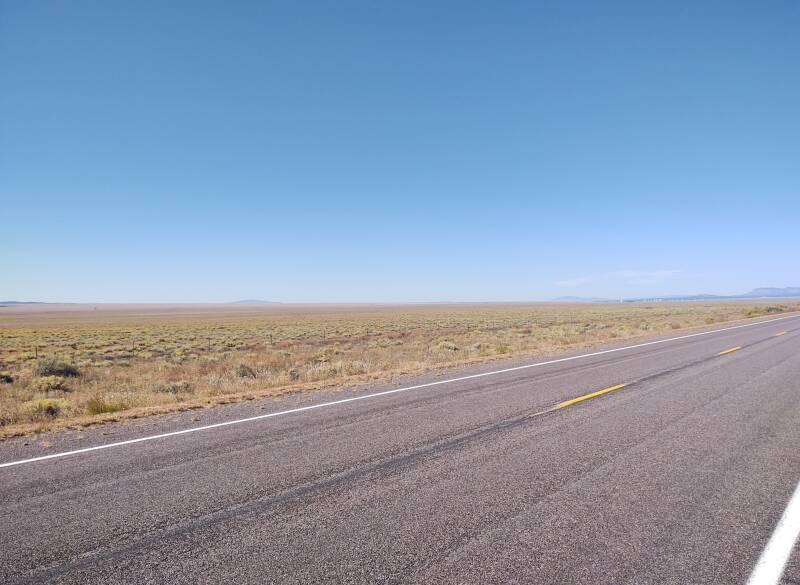
The Karl G. Jansky Very Large Array
The Very Large Array was built in 1973–1975. It is made up of twenty-seven 25-meter radio telescope dish antennas, with a 28th one being renovated at all times.
The antennas are placed on sturdy mounts along three 21-kilometer tracks in a Y shape. The tracks are dual rail tracks, and a specially designed locomotive relocates the individual antennas to change the characteristics of what functions as an array type antenna.
The array cycles through various configurations, with the antennas repositioned every three to four months.
Using aperture synthesis interferometry, the array provides angular resolution from 0.2 to 0.04 arcseconds, depending on the wavelength at which they're gathering data. The individual dishes cover from 74 MHz to 50 GHz, so from 400 cm to 0.7 cm.
In 2011 the array was renamed for Karl Jansky, one of the founders of radio astronomy. In April 1933, Jansky announced his observation of radio waves emenating from the center of the Milky Way galaxy in the constellation Sagittarius. Now we know that Sagittarius A, that signal's source, contains a supermassive black hole.
The self-guided tour starts at a comparatively small antenna from an earlier project.
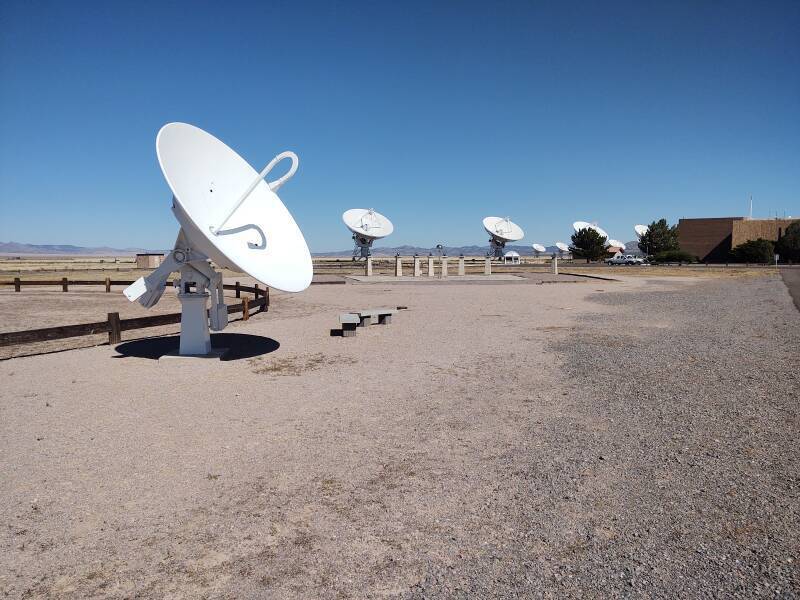
Rectangular feedline supports a horn at the prime focus,

Also near the visitor's center is the Long Wavelength Array or LWA. It's a 16×16 array of crossed broadband bowtie-shaped dipole antennas, like this isolated one. There's one array here, visible in the background, and another in the Sevilleta National Wildlife Refuge. That's close to the Interstate rest area where I took the first picture above.

The LWA operates at 10–88 MHz. That includes signals from pulsars, supernova remnants, the interstellar medium, and other phenomena. It can also measure coronal mass ejections from the Sun and radio flares from Jupiter. I'm impressed that the above antenna is useful all the way down to 10 MHz, a wavelength of 30 meters. The bow-tie shape really broadens the useful bandwidth.
On to the large dish array! There are nine dishes on each leg of the Y, each of them twenty-five meters in diameter. The dish surface is accurate to 0.5 millimeter, needed for performance at the the high end of its frequency range at 50 GHz.
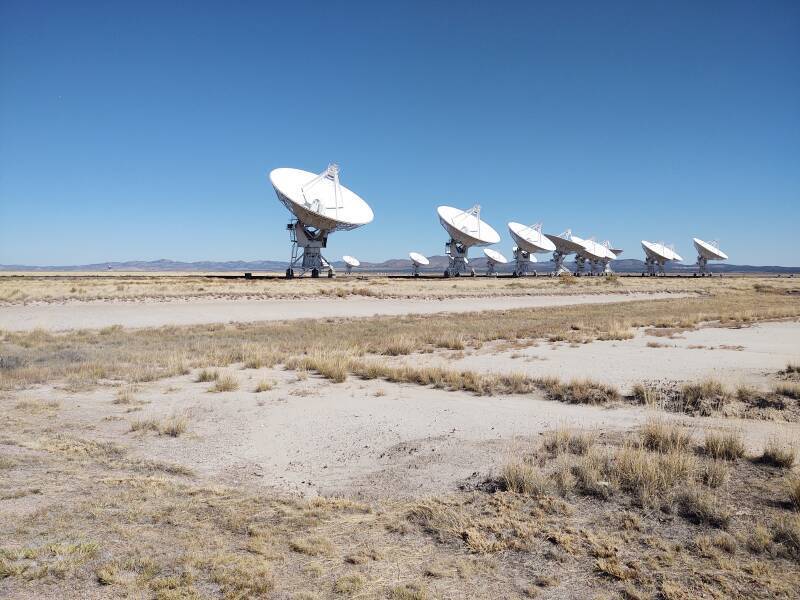
Each of the large dish antennas is what's called an offset cassegrain design. The tripod positions an asymmetric subreflector near the focal point of the dish. That subreflector sends the collected signal to the appropriate one of the horn antennas clustered at the center of the main dish surface. Each horn antenna and its receiver is specific for a frequency range.

The receiver for each frequency-specific horn is cooled to 18 °K. The weak received signals are amplified, converted to an intermediate frequency, and carried to the control building through a buried waveguide. Here's a cut-open 8.1–8.8 GHz (3.6 cm) feed horn and its receiver and IF converter, seen in the visitors' center.
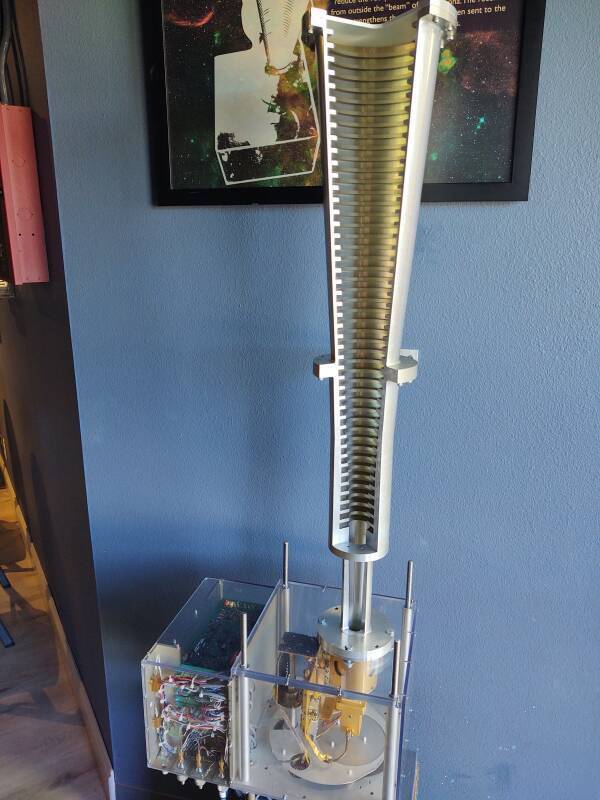
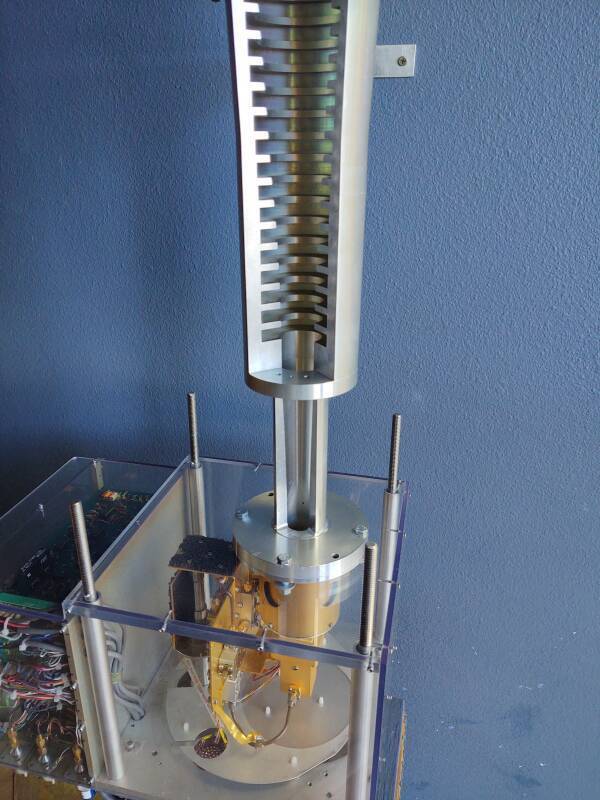
A custom-built correlator built by the National Research Council of Canada combines and analyzes the signals to perform interferometry, in which the collection of 27 dishes functions as a single aperture. Soon before my visit, NRC finished building a new correlator for ALMA, the Atacama Large Millimeter/Submillimeter Array in northern Chile.
National Radio Astronomy Observatory videos VLA correlator background VLA data collection and analysis manuals


Protected frequencies for radio astronomy.
| Frequency | Use |
| 13.36 – 13.41 MHz | |
| 25.55 – 25.67 MHz | |
| 37.50 – 38.25 MHz | Continuum |
| 73.00 – 74.60 MHz | Solar wind, continuum |
| 80.50 – 82.50 MHz | Pulsar observation |
| 150.05 – 153.00 MHz | Continuum, pulsar observation, solar observation |
| 322.0 – 328.6 MHz | Continuum, VLBI |
| 406.1 – 410.0 MHz | Continuum, pulsar observation |
| 608.0 – 614.0 MHz | Continuum, VLBI |
| 1400.0 – 1427.0 MHz | 21 cm hydrogen line |
| 1660.0 – 1670.0 MHz | VLBI, spectral lines, continuum |
| 1718.8 – 1722.2 MHz | |
| 2655.0 – 2700.0 MHz | Continuum |
| 3260.0 – 3267.0 MHz | |
| 3332.0 – 3339.0 MHz | |
| 3345.8 – 3352.5 MHz | |
| 4800.0 – 5030.0 MHz | Continuum, VLBI |
| Frequency | Use |
| 6650 – 6675.2 MHz | Continuum, VLBI |
| 10.60 – 10.70 GHz | Continuum, VLBI |
| 14.47 – 14.50 GHz | Spectral line, VLBI |
| 15.20 – 15.40 GHz | Continuum, VLBI |
| 22.01 – 22.50 GHz | Spectral lines — water |
| 23.07 – 23.12 GHz | Spectral lines |
| 23.60 – 24.00 GHz | Spectral lines — ammonia |
| 31.20 – 31.80 GHz | Continuum |
| 36.43 – 36.50 GHz | Spectral lines — hydrogen cyanide, hydroxil |
| 42.50 – 43.50 GHz | Spectral lines — silicon monoxide |
| 48.94 – 49.04 GHz | Spectral lines — carbon monosulphide |
| 51.40 – 54.25 GHz | |
| 58.20 – 59.00 GHz | |
| 72.77 – 72.91 GHz | Spectral lines — formaldehyde |
| 86.00 – 94.00 GHz | Spectral lines, continuum |
| 95.00 – 100.00 GHz | Spectral lines, continuum |
No one is in sight, but you hear equipment running — the refrigeration keeping the receiver just 18 degrees above absolute zero, and the electric motors slewing the dish to track the target.
The slightly tapering concrete pillars are stationary, precisely aligned for when a dish is placed here. The specialized locomotive, straddling the two sets of rails, barely fits under the steel frame. It lifts the dish off this set of three mounts, and carries it to another.

Back at one of the main lines of the "Y", the locomotive raises one wheel set at a time, rotating it 90° and lowering it onto one of the main line tracks.
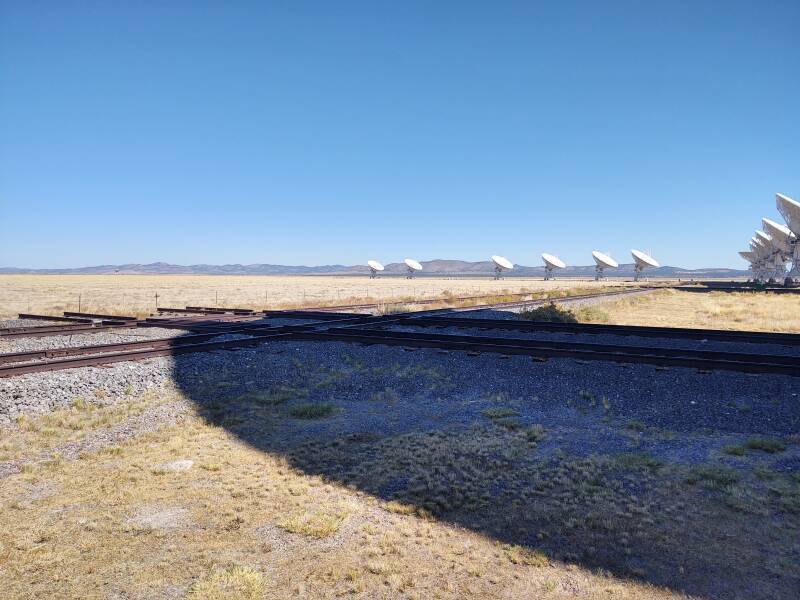

A 28th dish is always in "The Barn" undergoing maintenance and upgrades.

An upgrade over roughly 2001–2011 upgraded the electronics, and the array was renamed the Karl G. Jansky Very Large Array.
The VLA Sky Survey began in 2017. It aims to image the entire sky visible to the VLA (that is, north of declination –40°) at frequencies from 2 to 4 GHz with a resolution of 2.5 arcseconds. It's expected to finish in 2024, having collected data on five million radio sources.
The National Science Foundation has announced plans for the Next Generation Very Large Array, operating at 1.2–116 GHz, or 21 cm to 2.6 mm. The core of the ngVLA will be here, with other antennas across New Mexico, Arizona, Texas, and northern Mexico, plus long-baseline antennas in Hawaii, Washington, California, Iowa, West Virginia, New Hampshire, Canada, Puerto Rico, and the U.S. Virgin Islands.
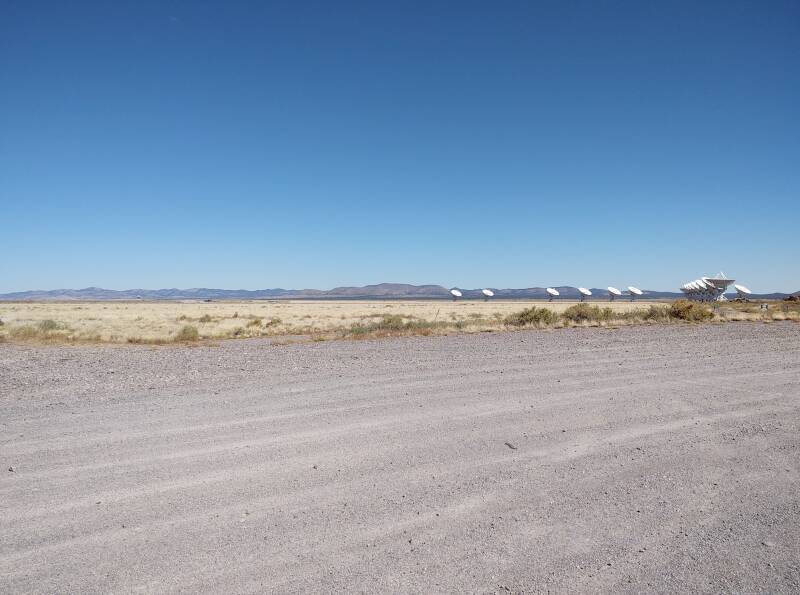
Back in Socorro
Back in Socorro I had a great late lunch at La Pasadita. Enchiladas verde, of course.

Then I explored central Socorro some more.
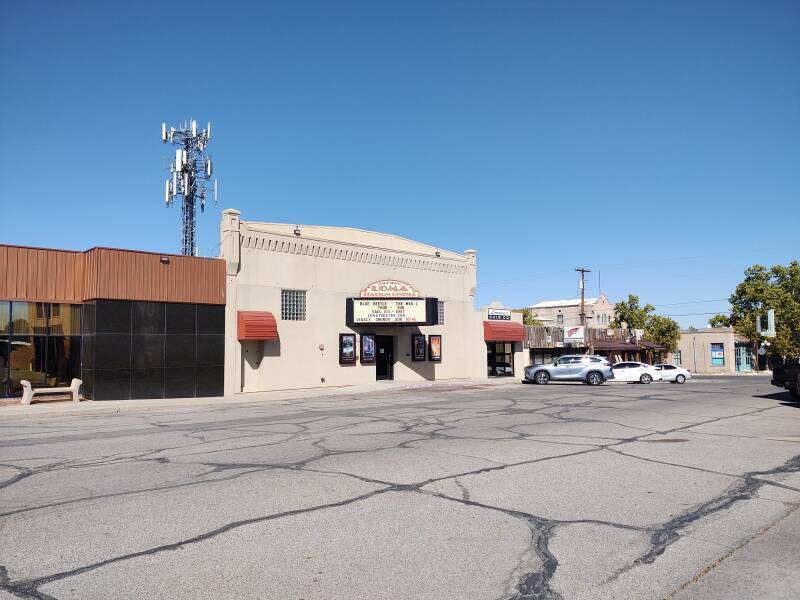

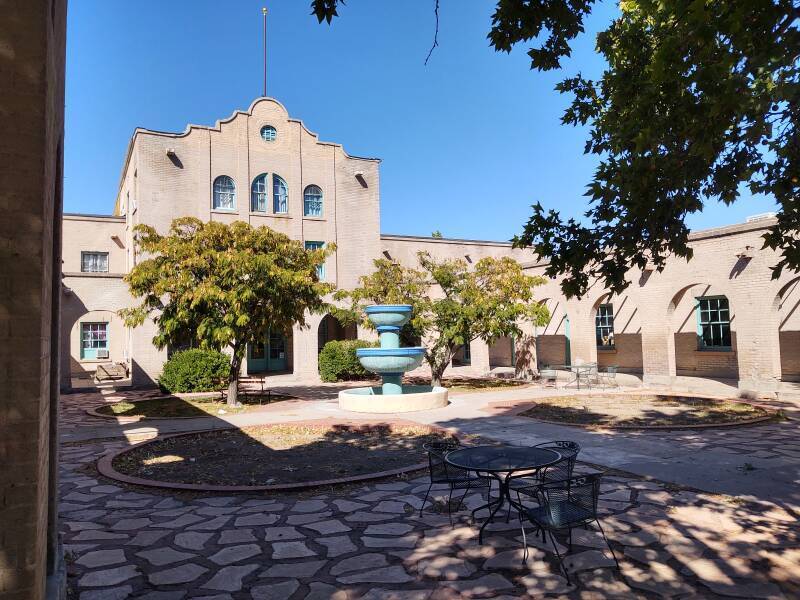
The Socorro UAP Incident Site
Someone has taken the trouble to tell Google Maps about the site, even using the term UAP or Unidentified Aerial (or Anomalous) Phenomenon which the U.S. Government began using in 2022.
South on California, the main road through town; off of that onto a side street, then a gravel hill up a steep slope. Just a little further on the left is a pull-off.
It's in an arroyo, what I would call a gully. Much bigger than a ditch but not any more auspicious.
Here's the view to the right, looking west up the arroyo toward the Magdalena Ridge between Socorro and the VLA.
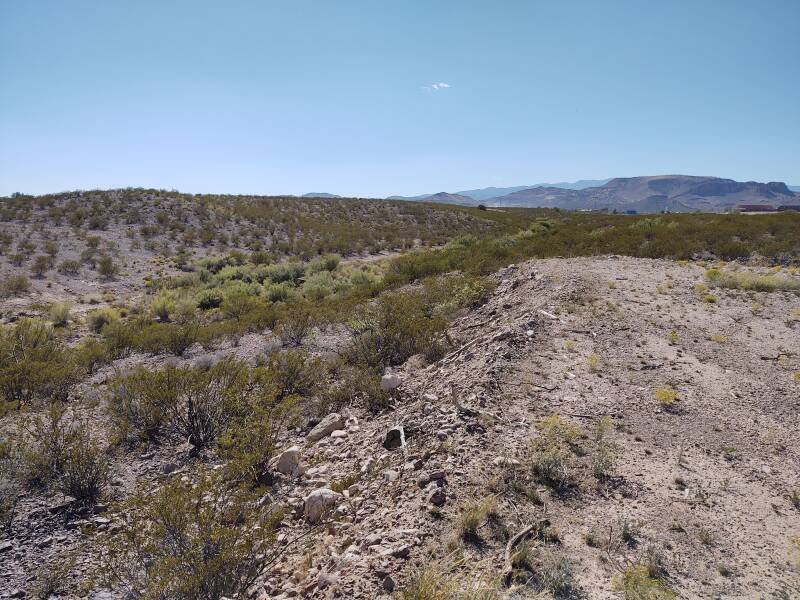
And the view to the left, looking east down the arroyo and past the north end of White Sands Missile Range, which is toward the right edge.
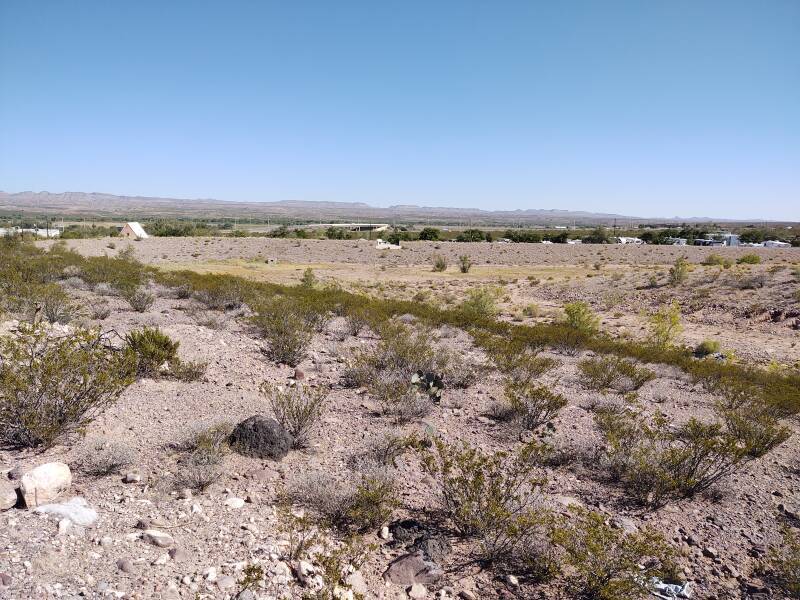
And finally, looking straight across the arroyo and down to the UAP Landing Site itself.
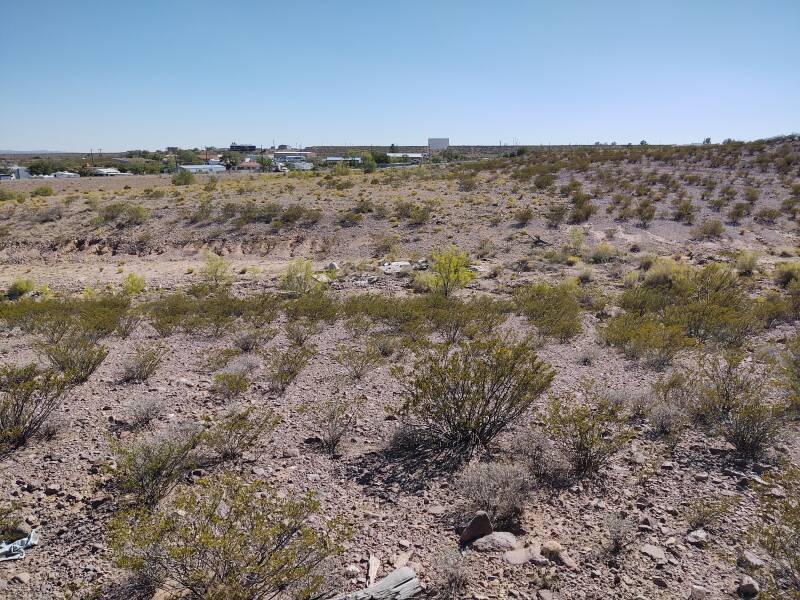
Lonnie Zamora reported seeing the strange craft in April 1964. Two years later, the president of the county's Chamber of Commerce proposed developing the site as a tourist attraction. Someone built stone stairs leading down into the arroyo, and a stone walkway around the landing site with wooden benches upon which to sit and ponder the meaning of it all. But you see no trace of that infrastructure in the above picture.
That's because the touristic walkway was intentionally built in the wrong place, because of persistent local rumors that the actual site was radioactive.
Lonnie Zamora tried to escape the subject. He began avoiding the Air Force investigators and UFO enthusiasts. He left the police force and managed a gasoline station. In 2009, at the age of 76, he died in Socorro of a heart attack.
Some skeptics have slightly modified the set of possibilities for Zamora's purported sighting to:
- He saw an early Lunar Module flight test at White Sands Missile Range, or
- He was a victim of a prank run by university students, or
- He was an active participant in a hoax organized by town leaders
From here I drove south and then east across the north edge of White Sands Missile Range, toward Alamogordo and White Sands National Park.
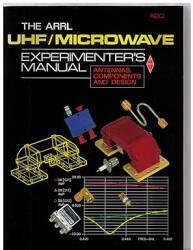
Yes, in New Mexico it's generally spelled "chile" and refers to a specific cultivar group, while "chili" refers to the stew, meaning that green chile chili exists.